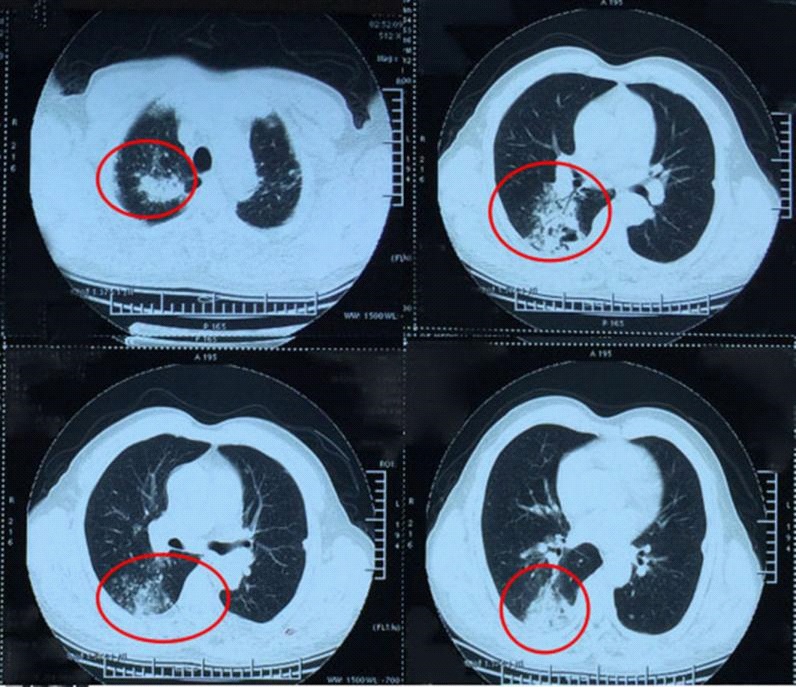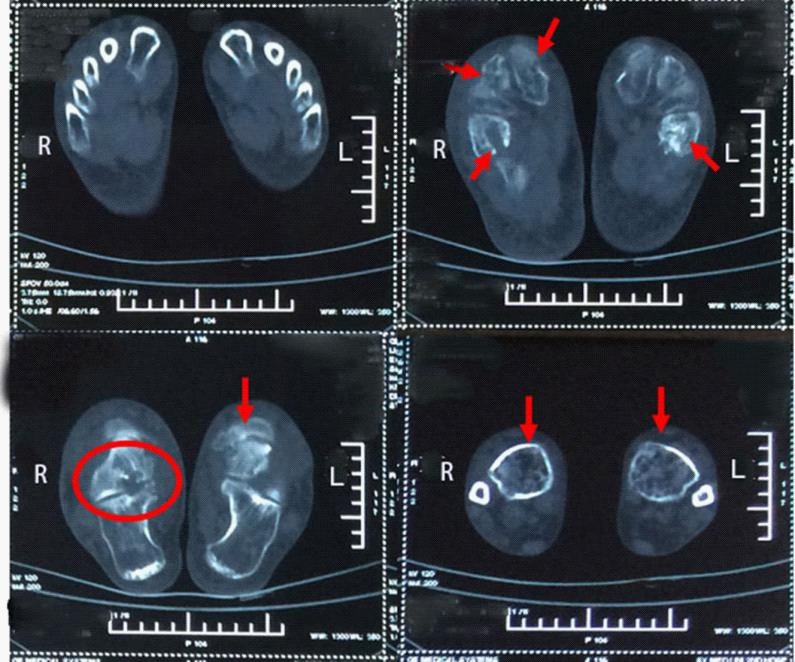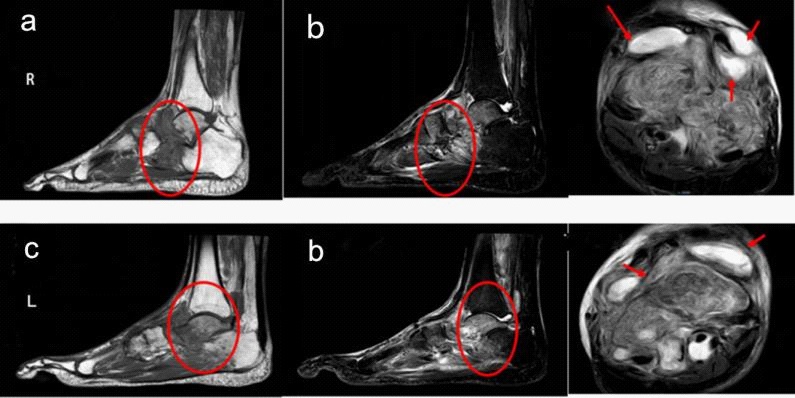
Journal of Clinical Images and Medical Case Reports
ISSN 2766-7820
Case Report - Open Access, Volume 2
Tuberculosis of bilateral ankles: Misdiagnosed as rheumatoid arthritis
Haiyao Wang1; Ping He2; Gailian Zhang3*; Jinfang Gao1; Liyun Zhang1
1 Department of Rheumatology, Shanxi Bethune Hospital, Shanxi Academy of Medical Sciences, Shanxi Bethune Hospital Affiliated to Shanxi Medical University, Taiyuan 030032, Shanxi, China.
2 Department of Nephrology, Changzhi People’s Hospital, Changzhi 046000, Shanxi, China.
3 Department of Rheumatology, Shanxi Provincial People’s Hospital, Taiyuan 030012, Shanxi, China.
*Corresponding Author: Gailian Zhang
Department of Rheumatology, Shanxi Provincial
People’s Hospital, Taiyuan 030012, Shanxi, China.
Email: 13754820091@sina.com
Received : May 01, 2021
Accepted : Jun 15, 2021
Published : Jun 18, 2021
Archived : www.jcimcr.org
Copyright : © Zhang G (2021).
Abstract
The osteoarticular tuberculosis is a uncommon diease, which is accout for 0.1%-0.3% of Tuberculosis (TB). The involoment of foot and ankle is only 0.01%-0.03% of TB, particularly the bilateral feet and ankles are affected is extremely rare. Futhermore, its clinical manifestation is atypical and similar with autoimmune disorder, subacute or chronic pyogenic arthritis, osteochondrosis, benign bone tumors and so on, which conduce to the delay of its diagnose and therapy along with unfavourable prognosis. Here we present a case of a 52-year-old man with bilateral feet and ankles tuberculous arthritis, misdiagnosed successively Rheumatoid Arthritis (RA) and Poncet’s diease. It is hope that can enhance the alertness about osteoarticular tuberculosis.
Keywords: Osteoarticular tuberculosis; ankle; foot; misdignose.
Citation: Wang H, He P, Zhang G, Gao J, Zhang L. Tuberculosis of bilateral ankles: Misdiagnosed as rheumatoid arthritis. J Clin Images Med Case Rep. 2021; 2(3): 1192.
Introduction
TB is a chronic infection caused by mycobacterium tuberculosis. Osteoarticular Tuberculosis (Osteoarticular TB) is scarce, accounting for about 0.1% - 0.3% of TB. Among the osteoarticular tuberculosis, the foot and ankle suffered only 8%-10% [1]. Extremely rare, patients with osteoarticular TB develop a form of bilateral ankles and feet arthritis. Additionally, because of its insidious onset and the atypical clinical symptoms that can mimic other diseases like subacute or chronic pyogenic arthritis, traumatic arthritis, rheumatoid arthritis, tuberculous rheumatism, osteochondrosis and benign bone tumors, the misdiagnosis rate is high [2-4]. Here we present a case of a 52-year-old man with bilateral feet and ankles tuberculous arthritis, misdiagnosed successively Rheumatoid Arthritis (RA) and Poncet’s diease.
Case report
A 52-year-old workman was admitted to our hospital complaining of a painful swelling of his both feet which had lasted for over a year. In April 2015, the patient suffered from swelling and pain on his both ankles and the dorsum of both feet without any cause. There was no limitation of movement. No other symptoms were reported. He had a history of hypertension and appendectomy, but no history of trauma. The traditional Chinese drug and acupuncture treatment were showed poor efficacy and thus he was admitted to local hospital at the first time. Physical examination revealed his bilateral ankles and the dorsum of feet were swelling and tender. Haematological parameters (complete blood count, hepatic function and kidney function, erythrocyte sedimentation rate and C-reactive protien) were normal. Autoantibody test revealed Antinuclear Antibody (ANA) posive 1:100S and The feet radiographs were no obvious abnormity. And then he was diagnosed as RA, treated with methylprednisolone (intravenous, 160mg twice a day for 3 days), leflunomide (10 mg daily) and hydroxychloroquine sulfate (200 mg twice daily). After 2 months of treatment, the swelling improved, but relapsed when drug withdrawal. In October 2016, he was hospitalized again beacuse of his more swollen feet and ankles and underwent chest CT, suggesting the possibility of tuberculosis (Figure 1). Then he was suspected of “Tuberculous Rheumatism” and transferred to a tuberculosis hospital for treatment. Pertinent laboratory tests revealed the Erythrocyte Sedimentation Rate (ESR) was 81 mm/hr, C-Reactive Protein (CRP) was 42.51 mg/L and tuberculosis antibody (IgG, 38 KDa) was positive. Empiric Anti-Tuberculous (anti-TB) treatment was instituted, using a regimen of isoniazid, rifampicin, pyrazinamide for half a month. However his bilateral feet and ankles got more swelling and difficult to walk, coming along with fever. Consequently, he was admitted to our hospital. Physical examination was same as before. The leukocyte cout was 8.0×109 /L with a predominance of neutrophil (N 83.3%), ESR 50 mm/hr, CRP 46.79 mg /L and Rheumatoid Factor (RF) was negative. Immune indicator (IgG, IgA, IgM, C3, C4) were normal and immune-related antibodies and tumor markers were negative. Computed Tomography scan (CT) of the foot showed multi-focal destruction, sclerosis and sequestrum formation of tarsal bone, the bony destruction in calcaneus, talus and navicular and osteoporsis in the lower tibia (Figure 2). Ultrasound of the ankles indicated multiple well-defined ellipse shadows, of which the internal was poor-medium echo and hyper-echo on edge, surrounded by the PD signal, existed on the bone surface. In addition, the bipedal Magnetic Resonance Imaging (MRI) revealed joint effusion, multiple bony destruction, bone marrow edema and subcutaneous soft tissue edema, with abnormal signals around ankles (Figure 3). The acid-fast bacillus was postive in the fifth examination of sputum smears. The ultrasound-guided ankle arthroparacentesis was performed for three times and mycobacterium tuberculosis was detected for 3.44×103 /L. The tuberculosis of bilateral ankles was established and multidrug anti-tuberculosis treatment was administered daily with isoniazid 300 mg, rifampin 450 mg, ethambutol 750 mg and pyrazinamide 500 mg. After two weeks, his swollen feet and ankles were improved without pain and fever. Then he was discharged and continued anti-tuberculosis treatment. At follow-up, the patient’s general health condition is satisfactory.
Nowadays, TB is still a serious threat to human health. Pulmonary TB is the most common pattern of manifestaion, but Extrapulmonary TB (EPTB) contributes significantly to disability and mortality [3]. Timely diagnosis and correct treatment are critical to avoid functional disability. In this paper, The patient failed to be present the classical systemic symptoms and underwent two misdiagnosis successively. The patient characterized by swelling and pain of both feet, without typical systemic symptoms and the ANA is postive, which is easily misdiagnosed as RA. But he was failing to respond to the treatment using glucocorticoid and immunosuppressive agents, thus excluding the diagnosis of RA. And Jae Hyoung Im et al’s research shows that there is a certain association between tuberculosis and ANA, and most frequently in the patients with extrapulmonary tuberculosis [5]. Tuberculous rheumatism, also known as ‘Poncet’s disease’, is a sterile reactive arthritis caused by tuberculotoxin, mostly without bone destruction and anti-tuberculosis treatment is effective [6]. Although the clinical manifestations of this patient are similar to that of this disease and effective in anti-tuberculosis treatment, the imaging findings of both feet showed obvious bone destruction and tuberculous bacilli can be found in joint fluid, which could be clearly diagnosed as bilateral ankles tuberculosis.
Conclusion
In the clinicial, the patient characterized by swelling and pain of both feet, without typical systemic symptoms and immunerelated antibodies should carry out imaging examination of pulmonary actively to determine whether there are tuberculose focus in the lung and to be vigilant against the occurrence of osteoarthrosis in rare sites. Beause of paucibacillary character of the disease, the risk of TB infection cannot be ruled out even if the acid-fast bacilli staining and culture are negative. We should promote acid-fast bacilli staining and culture repeatedly. Furthermore, we should pay close attention to the imaging process of the lesions. If necessary, the diagnosis should be confirmed by surgical intervention.
Declarations
Funding: Not applicable.
Conflicts of interest: The authors declare that they have no competing interest.
Availability of data and material: The dataset supporting the conclusions of this manuscript is included with in the manuscript.
Authors' contributions: All authors participated in the completing the manuscript. All authors read and approval the final manuscript.
Acknowledgements: Not applicable.
References
- Dhillon MS, Aggarwal S, Prabhakar S, Bachhal V. Tuberculosis of the foot: An osteolytic variety. INDIAN J ORTHOP. 2012; 46: 206- 211.
- Faroug R, Psyllakis P, Gulati A, Makvana S, Pareek M, et al. Diagnosis and treatment of tuberculosis of the foot and ankle-A literature review. Foot (Edinb). 2018; 37: 105-112.
- Rando MM, De Matteis G, Gessi M, Bartoli M, Galli M, et al. Tuberculous Arthritis of the Ankle. Eur J Case Rep Intern Med. 2018; 5: 870.
- Grubisic F, Boric I, Segota A, Kruslin B, Grazio S. An unusual manifestation of osteoarticular tuberculosis: case report. ACTA CLIN CROAT. 2014; 53: 237-241.
- Im JH, Chung MH, Park YK, Kwon HY, Baek JH, Lee SY, et al. Antinuclear antibodies in infectious diseases. Infect Dis (Lond). 2020; 52: 177-185.
- Sait S, Mubashir M, Anwar R, Khan N. Poncet’s disease (tubercular rheumatism) with primary involvement of the foot - A case report. FOOT ANKLE SURG. 2016; 22: e17-20.



